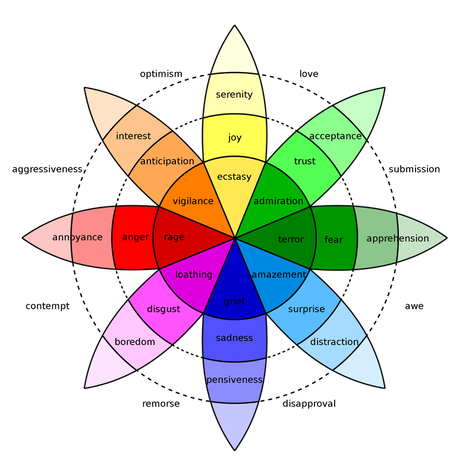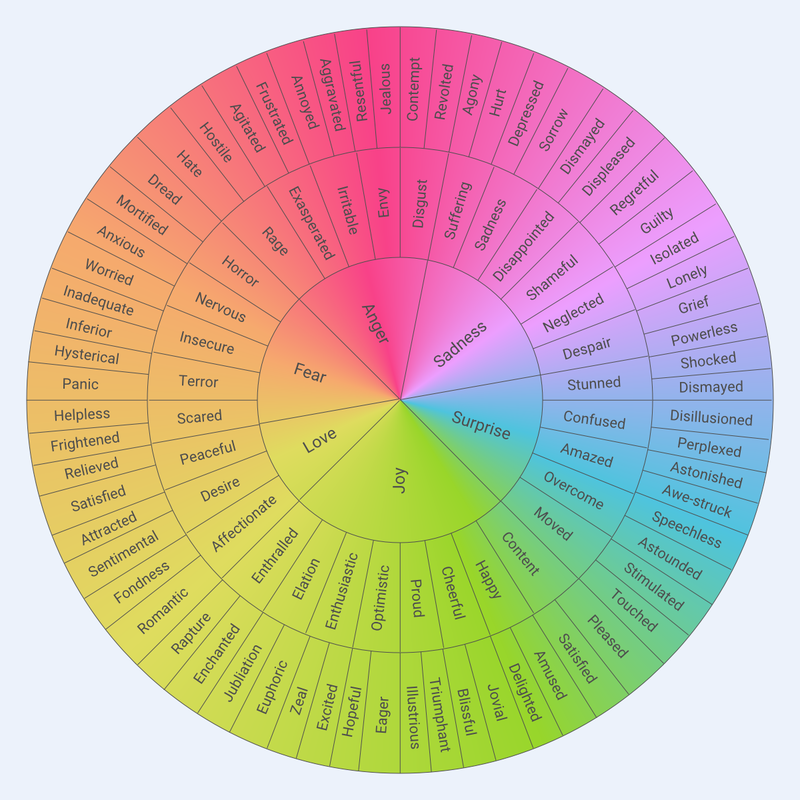Birth of an emotion.
Our emotions are happening constantly. They are released as electrochemical signals in our brains, and interpreted based on how we perceive the world around us.
While there are emotions we want to feel (and others we don't) our emotions are neither inherently good nor bad. They are simply expressing a need. As an example, vigilance and amazement are two different emotions; the first feeling most of us associate with aggressiveness and the second feeling with awe. Both are responses to a particular circumstance, so you could think of them as being two sides of one coin. All our emotions interrelate to each other in this way, which is why emotions are messy and complex (and why an escape room team building event at work will create competitiveness for one person and curiosity in another).
Emotions can also be very nuanced; some emotions are experienced as a mild expression, whereas other emotions can be very intense. A good example is annoyance; a mild emotion (one we all feel from time to time) whose most intense expression escalates to rage if ignored (annoyance > anger > rage).
(Read more from Six Seconds about our emotions and how we interpret them here)
While there are emotions we want to feel (and others we don't) our emotions are neither inherently good nor bad. They are simply expressing a need. As an example, vigilance and amazement are two different emotions; the first feeling most of us associate with aggressiveness and the second feeling with awe. Both are responses to a particular circumstance, so you could think of them as being two sides of one coin. All our emotions interrelate to each other in this way, which is why emotions are messy and complex (and why an escape room team building event at work will create competitiveness for one person and curiosity in another).
Emotions can also be very nuanced; some emotions are experienced as a mild expression, whereas other emotions can be very intense. A good example is annoyance; a mild emotion (one we all feel from time to time) whose most intense expression escalates to rage if ignored (annoyance > anger > rage).
(Read more from Six Seconds about our emotions and how we interpret them here)
Emotions are a compass, guiding us to what is most needed in each moment.
Why is naming emotions a life skill?
The purpose of our emotions is to direct our actions. Being the wonderfully complex creatures we humans are, we need an equally complex navigation system. Our emotions arise as an expression of need, grabbing our attention and pointing us towards action. As an example, annoyance (when named) means you can have a thoughtful conversation with your boss about how they often interrupt you in meetings. Ignore annoyance, and this emotion may intensify to anger, or rage, and the actions you take with intense emotion in play may be less thoughtful (and certainly more stressful).
By learning how to be more present, you can witness an emotion as it arises, giving you more opportunity to be aware of your emotions, recognizing them, so you can work with them (rather than avoid or ignore them). This pause, and the connection it provides, gives you options that empower you to work with what you are feeling, rather than reacting to it (response, not reaction). At work, this is the difference between saying something thoughtful because you are responding to meet your needs: ("I don't know if you realize it, but you interrupted me several times in the meeting today. I would like to talk about it."), versus a career-limiting move that just explodes because you ignored your feelings and they intensified on you: ("DON'T YOU EVER INTERRUPT ME LIKE THAT AGAIN YOU GIANT EGG-HEAD!").
It is possible to both avoid your feelings, and not scream at your boss. This is the life skill piece, because your intense emotions need to go somewhere when they don't have an opportunity for expression. Intense, unexpressed emotion remains inside, creating a stress response (flight or flight) that will impact your well-being (short term, and when perpetual, long-term). Healthy expression of emotions takes place when you name them, being non-judgmental and compassionate with yourself ("Yes, I am annoyed... I am annoyed that I am annoyed, but it's OK to feel this way...") and you find a skillful way to met your emotional needs.
Naming emotions is the first step towards lessening their intensity (and your stress); it is a practice that nourishes both your self-compassion, and your great potential.
By learning how to be more present, you can witness an emotion as it arises, giving you more opportunity to be aware of your emotions, recognizing them, so you can work with them (rather than avoid or ignore them). This pause, and the connection it provides, gives you options that empower you to work with what you are feeling, rather than reacting to it (response, not reaction). At work, this is the difference between saying something thoughtful because you are responding to meet your needs: ("I don't know if you realize it, but you interrupted me several times in the meeting today. I would like to talk about it."), versus a career-limiting move that just explodes because you ignored your feelings and they intensified on you: ("DON'T YOU EVER INTERRUPT ME LIKE THAT AGAIN YOU GIANT EGG-HEAD!").
It is possible to both avoid your feelings, and not scream at your boss. This is the life skill piece, because your intense emotions need to go somewhere when they don't have an opportunity for expression. Intense, unexpressed emotion remains inside, creating a stress response (flight or flight) that will impact your well-being (short term, and when perpetual, long-term). Healthy expression of emotions takes place when you name them, being non-judgmental and compassionate with yourself ("Yes, I am annoyed... I am annoyed that I am annoyed, but it's OK to feel this way...") and you find a skillful way to met your emotional needs.
Naming emotions is the first step towards lessening their intensity (and your stress); it is a practice that nourishes both your self-compassion, and your great potential.
Ignoring emotions compromises who you are and how you show up in the world. In essence, it breaks your compass, impacting your physical and mental health, your well-being and happiness.
Naming emotions.
Do you remember the "naming emotions" class you took in school? That's because there wasn't one.
Asking you to name your emotions sounds simple, but it can be challenging because we don't do this, or use this language, everyday. To support your emotional navigation there is a tool to help you identify, and name, your emotions. It's called Plutchik's Wheel of Emotion.
Asking you to name your emotions sounds simple, but it can be challenging because we don't do this, or use this language, everyday. To support your emotional navigation there is a tool to help you identify, and name, your emotions. It's called Plutchik's Wheel of Emotion.
|
Emotions "move" within us; their intensity evolves and shifts as our emotions are explored and understood.
Navigating emotions.
The primary purpose in naming an emotion is to empower you to "see" it, feel it, and make a determination about what to do with it, because emotion often points to an unmet need (a call to action). The need to belong, to be safe, or (as in the example with an interrupting boss), the need to be respected (dignity). When you ignore your needs (or are not in touch with them), your emotions intensify. When you name your emotions, feel them, and connect to your needs, you can then do something beneficial with your emotions (and they will become less intense).
The next step, after naming your emotion(s), is to identify the need it's expressing so you can work with the emotion (navigating it). This requires discernment to know the difference between a want and a need. To continue with our example; you may want your boss to be more polite (something you do not control), but you need your boss to know how interrupting impacts you and the way your work is perceived (something you do control). The act of acknowledging your emotions alleviates their intensity, allowing you to meet your needs, and do so as your best self. Acting on your needs, can move an emotion from one you don't enjoy feeling, to one you do: ("I'm glad I let my boss know how it felt to be interrupted, it will happen less often now.").
The next step, after naming your emotion(s), is to identify the need it's expressing so you can work with the emotion (navigating it). This requires discernment to know the difference between a want and a need. To continue with our example; you may want your boss to be more polite (something you do not control), but you need your boss to know how interrupting impacts you and the way your work is perceived (something you do control). The act of acknowledging your emotions alleviates their intensity, allowing you to meet your needs, and do so as your best self. Acting on your needs, can move an emotion from one you don't enjoy feeling, to one you do: ("I'm glad I let my boss know how it felt to be interrupted, it will happen less often now.").
Instead of resisting any emotion, the best way to dispel it is to enter it fully, embrace it and see through your resistance.
- Deepak Chopra
|


